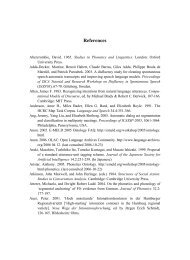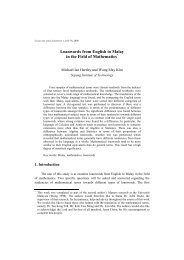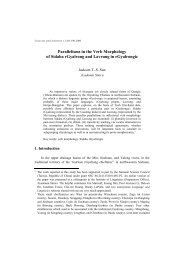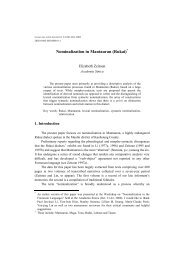A Brief Syntactic Typology of Philippine Languages - Academia Sinica
A Brief Syntactic Typology of Philippine Languages - Academia Sinica
A Brief Syntactic Typology of Philippine Languages - Academia Sinica
Create successful ePaper yourself
Turn your PDF publications into a flip-book with our unique Google optimized e-Paper software.
Lawrence A. Reid and Hsiu-chuan Liao<br />
literature as ‘locative/referent focus’. Most AN verbs imply that their undergoer is an entity<br />
that is only partly, not entirely affected, or only whose surface is affected, or the end point<br />
<strong>of</strong> the action, the place to which or from which some other entity is directed. We call the<br />
feature that is part <strong>of</strong> such verb with an AN ending, the LOCAL AFFECT feature ([+lfct]).<br />
460<br />
(69) Mamanwa (Miller 1964:90)<br />
Bonalan=mo ya baroy.<br />
[+trns,+lfct]<br />
pound on=GEN.2S DET leaf<br />
‘You (sg) will pound (on) the leaf.’<br />
3.3.1.1.2.1.3 Reflexes <strong>of</strong> PEF */i-<br />
Reflexes <strong>of</strong> PEF */i- (from earlier *Si-) are similarly widespread throughout the<br />
<strong>Philippine</strong>s. The verbs <strong>of</strong> this class (henceforth I verbs) are those that have commonly<br />
been labeled in much <strong>of</strong> the literature on <strong>Philippine</strong> languages as ‘instrument/associative<br />
focus’. Most I verbs imply that their undergoer is moved in space, directed towards, or<br />
brought into association with some entity. We call the feature that is part <strong>of</strong> such a verb<br />
beginning with an I, the MANNER AFFECT feature ([+mfct]).<br />
(70) Guinaang Bontok<br />
/iyáli=m man nan kapi=k.<br />
[+trns,+mfct]<br />
come with=GEN.2S please DET c<strong>of</strong>fee=GEN.1S<br />
‘Please bring (lit., come-with) my c<strong>of</strong>fee.’<br />
3.3.1.1.2.1.4 Beneficiary affect<br />
In addition to the three affect features that imply the semantic interpretation <strong>of</strong> the<br />
undergoer that we have discussed, <strong>Philippine</strong> languages can also typically imply the<br />
interpretation <strong>of</strong> the undergoer as beneficiary <strong>of</strong> an action. We refer to this feature as the<br />
BENEFICIARY AFFECT feature ([+bfct]). There are at least five types <strong>of</strong> languages in the<br />
<strong>Philippine</strong>s, depending on how they mark such verbs: (1) those that use an I verb and no<br />
other for this purpose, such as Ivatan (71); (2) those that use an AN verb and no other for<br />
this purpose, such as Maranao (72); (3) those that use a “circumfix” I- -AN on such verbs,<br />
such as Balangaw (73), and most languages <strong>of</strong> the northern <strong>Philippine</strong>s; (4) those that<br />
use either an I verb or AN verb, such as Mamanwa (74) and Tagalog (depending on the<br />
verb); and (5) those that use either an I- -AN verb or an AN verb, depending on the verb,<br />
such as Ilokano (75).










